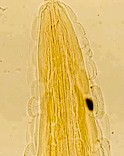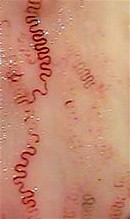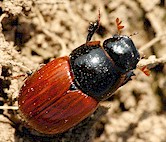Gongylonema is a genus of parasitic roundworms that has sheep and goats, and sometimes also horses, cattle, swine, poultry, horses, dogs, cats and numerous other wild and domestic mammals and birds as final hosts.
that has sheep and goats, and sometimes also horses, cattle, swine, poultry, horses, dogs, cats and numerous other wild and domestic mammals and birds as final hosts.
There are about 40 species worldwide. Prevalence is highly variable. A study in Iran showed that up to 16% of cattle may be infected.
The species most relevant for domestic animals are the following ones:
- Gongylonema pulchrum; the gullet worm, infects mammals, including horses; found worldwide.
- Gongylonema verrucosum; infects mammals, found in parts of Asia, Australia, Southern Africa and North America
- Gongylonema ingluvicola, infects poultry
The disease caused by Gongylonema worms is called gongylonemiasis.
Gongylonema pulchrum can very occasionally infect humans as well.
Are animals or infected with Gongylonema contagious for humans?
- NOT directly because the eggs of these worms shed by infected livestock or pets are not directly infective for humans. To become infected they have to be eaten by the beetles that act as intermediate hosts. For additional information read the chapter below on the life cycle.
You can find additional information in this site on the general biology of parasitic worms and/or roundworms.
Final location of Gongylonema
Predilection sites of adult worms are:
- Gongylonema pulchrum: wall of the esophagus or the rumen
- Gongylonema verrucosum: wall of the esophagus
- Gongylonema ingluvicula: wall of the crop, esophagus and sometimes proventriculum
Anatomy of Gongylonema

Adult Gongylonema pulchrum reach about 6 (males) to 14 (females) cm length, Gongylonema verrucosum are shorter (4 to 9 cm). They have a typical slender worm shape and have a yellowish-brownish to reddish color. The worm's body is covered with a cuticle, which is flexible but rather tough.
Typical for Gongylonema worms are cuticular platelets covering the anterior end. When embedded in the wall of the esophagus they show a typical zigzag shape.
Otherwise the worms have no external signs of segmentation. They have a tubular digestive system with two openings. They also have a nervous system but no excretory organs and no circulatory system, i.e. neither a heart nor blood vessels. Males have chitinous spicules for attaching to the female during copulation.
Gongylonema worms are not bloodsucking parasites but feed on tissues and fluids of the host.
The eggs are elliptical (~30x60 micrometers), thick-shelled and contain an embryo when shed with the feces.
Life cycle of Gongylonema

Gongylonema worms have an indirect life cycle with sheep, goats, dogs, cats, pigs and other carnivores or birds as final hosts, and dung beetles (e.g. of the genus Aphodius) or cockroaches as intermediate hosts. In addition, several vertebrates, including humans, can act as paratenic or transport hosts, i.e. the worms do not complete development but remain there as infective larvae waiting for the transport host to be ingested by a suitable final host.
Beetles or cockroaches eat the eggs shed with the feces of infested hosts. These eggs release the L1 larvae inside the intermediate host, which develop to infective L3 larvae. The final hosts become infected when eating such infected beetles or cockroaches, either directly (e.g. on pasture), or indirectly through contaminated feed.
The infective L3 larvae are released in the stomach of the final host. Most larvae migrate back to the esophagus and burrow in its wall where they become established, complete development to adults and start producing eggs. Other worms may burrow directly in the stomach wall.
Humans may become infected after accidental ingestion of beetles.
Harm caused by Gongylonema, symptoms and diagnosis
Gongylonema infections of livestock, horses or pets are mostly benign and cause no clinical signs. A slight inflammation of the esophagus or stomach wall may occur, but is usually asymptomatic. However infected organs (mostly used for sausage or charcuterie) are usually rejected at slaughter.
Diagnosis in livestock or pets is usually incidental after slaughter or necropsy. However, eggs can be detected after fecal examination.
Prevention and control of Gongylonema
Best prevention in endemic regions is to keep livestock or pets away from pasture or feed contaminated with infected beetles or cockroaches. Where these worms are a problem livestock may be kept indoors preferably on hard and dry floor.
Deworming livestock with anthelmintics is usually not indicated and mostly not cost-effective, because the economic impact is usually very low. In addition most commercial wormers are not approved for Gongylonema control.
There are so far no true vaccines against Gongylonema worms, neither for livestock, nor for pets. To learn more about vaccines against parasites of livestock and pets click here.
Biological control of Gongylonema worms (i.e. using its natural enemies) is so far not feasible. Learn more about biological control of worms.
You may be interested in an article in this site on medicinal plants against external and internal parasites.
Resistance of Gongylonema to anthelmintics
So far there are no reports on resistance of Gongylonema worms to anthelmintics.
This means that if an anthelmintic fails to achieve the expected efficacy, chance is very high that either the product was unsuited for the control of Gongylonema worms, or it was used incorrectly.
Learn more about parasite resistance and how it develops.
|
Ask your veterinary doctor! If available, follow more specific national or regional recommendations for Gongylonema control. |